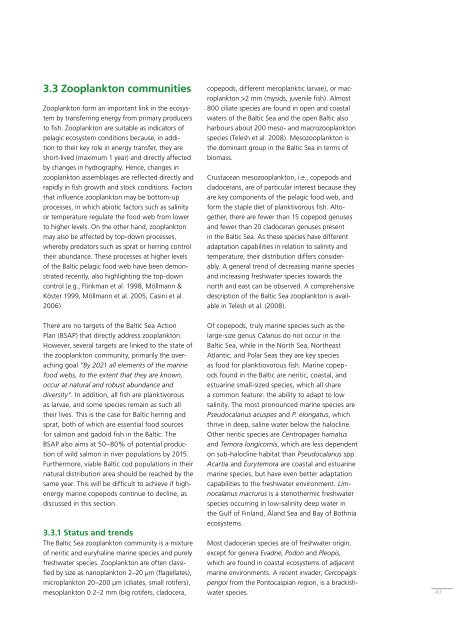BSEP116B Biodiversity in the Baltic Sea - Helcom
BSEP116B Biodiversity in the Baltic Sea - Helcom
BSEP116B Biodiversity in the Baltic Sea - Helcom
Create successful ePaper yourself
Turn your PDF publications into a flip-book with our unique Google optimized e-Paper software.
3.3 Zooplankton communities<br />
Zooplankton form an important l<strong>in</strong>k <strong>in</strong> <strong>the</strong> ecosystem<br />
by transferr<strong>in</strong>g energy from primary producers<br />
to fish. Zooplankton are suitable as <strong>in</strong>dicators of<br />
pelagic ecosystem conditions because, <strong>in</strong> addition<br />
to <strong>the</strong>ir key role <strong>in</strong> energy transfer, <strong>the</strong>y are<br />
short-lived (maximum 1 year) and directly affected<br />
by changes <strong>in</strong> hydrography. Hence, changes <strong>in</strong><br />
zooplankton assemblages are reflected directly and<br />
rapidly <strong>in</strong> fish growth and stock conditions. Factors<br />
that <strong>in</strong>fluence zooplankton may be bottom-up<br />
processes, <strong>in</strong> which abiotic factors such as sal<strong>in</strong>ity<br />
or temperature regulate <strong>the</strong> food web from lower<br />
to higher levels. On <strong>the</strong> o<strong>the</strong>r hand, zooplankton<br />
may also be affected by top-down processes,<br />
whereby predators such as sprat or herr<strong>in</strong>g control<br />
<strong>the</strong>ir abundance. These processes at higher levels<br />
of <strong>the</strong> <strong>Baltic</strong> pelagic food web have been demonstrated<br />
recently, also highlight<strong>in</strong>g <strong>the</strong> top-down<br />
control (e.g., Fl<strong>in</strong>kman et al. 1998, Möllmann &<br />
Köster 1999, Möllmann et al. 2005, Cas<strong>in</strong>i et al.<br />
2006).<br />
copepods, different meroplanktic larvae), or macroplankton<br />
>2 mm (mysids, juvenile fish). Almost<br />
800 ciliate species are found <strong>in</strong> open and coastal<br />
waters of <strong>the</strong> <strong>Baltic</strong> <strong>Sea</strong> and <strong>the</strong> open <strong>Baltic</strong> also<br />
harbours about 200 meso- and macrozooplankton<br />
species (Telesh et al. 2008). Mesozooplankton is<br />
<strong>the</strong> dom<strong>in</strong>ant group <strong>in</strong> <strong>the</strong> <strong>Baltic</strong> <strong>Sea</strong> <strong>in</strong> terms of<br />
biomass.<br />
Crustacean mesozooplankton, i.e., copepods and<br />
cladocerans, are of particular <strong>in</strong>terest because <strong>the</strong>y<br />
are key components of <strong>the</strong> pelagic food web, and<br />
form <strong>the</strong> staple diet of planktivorous fish. Altoge<strong>the</strong>r,<br />
<strong>the</strong>re are fewer than 15 copepod genuses<br />
and fewer than 20 cladoceran genuses present<br />
<strong>in</strong> <strong>the</strong> <strong>Baltic</strong> <strong>Sea</strong>. As <strong>the</strong>se species have different<br />
adaptation capabilities <strong>in</strong> relation to sal<strong>in</strong>ity and<br />
temperature, <strong>the</strong>ir distribution differs considerably.<br />
A general trend of decreas<strong>in</strong>g mar<strong>in</strong>e species<br />
and <strong>in</strong>creas<strong>in</strong>g freshwater species towards <strong>the</strong><br />
north and east can be observed. A comprehensive<br />
description of <strong>the</strong> <strong>Baltic</strong> <strong>Sea</strong> zooplankton is available<br />
<strong>in</strong> Telesh et al. (2008).<br />
There are no targets of <strong>the</strong> <strong>Baltic</strong> <strong>Sea</strong> Action<br />
Plan (BSAP) that directly address zooplankton.<br />
However, several targets are l<strong>in</strong>ked to <strong>the</strong> state of<br />
<strong>the</strong> zooplankton community, primarily <strong>the</strong> overach<strong>in</strong>g<br />
goal “By 2021 all elements of <strong>the</strong> mar<strong>in</strong>e<br />
food webs, to <strong>the</strong> extent that <strong>the</strong>y are known,<br />
occur at natural and robust abundance and<br />
diversity”. In addition, all fish are planktivorous<br />
as larvae, and some species rema<strong>in</strong> as such all<br />
<strong>the</strong>ir lives. This is <strong>the</strong> case for <strong>Baltic</strong> herr<strong>in</strong>g and<br />
sprat, both of which are essential food sources<br />
for salmon and gadoid fish <strong>in</strong> <strong>the</strong> <strong>Baltic</strong>. The<br />
BSAP also aims at 50–80% of potential production<br />
of wild salmon <strong>in</strong> river populations by 2015.<br />
Fur<strong>the</strong>rmore, viable <strong>Baltic</strong> cod populations <strong>in</strong> <strong>the</strong>ir<br />
natural distribution area should be reached by <strong>the</strong><br />
same year. This will be difficult to achieve if highenergy<br />
mar<strong>in</strong>e copepods cont<strong>in</strong>ue to decl<strong>in</strong>e, as<br />
discussed <strong>in</strong> this section.<br />
3.3.1 Status and trends<br />
The <strong>Baltic</strong> <strong>Sea</strong> zooplankton community is a mixture<br />
of neritic and euryhal<strong>in</strong>e mar<strong>in</strong>e species and purely<br />
freshwater species. Zooplankton are often classified<br />
by size as nanoplankton 2–20 µm (flagellates),<br />
microplankton 20–200 µm (ciliates, small rotifers),<br />
mesoplankton 0.2–2 mm (big rotifers, cladocera,<br />
Of copepods, truly mar<strong>in</strong>e species such as <strong>the</strong><br />
large-size genus Calanus do not occur <strong>in</strong> <strong>the</strong><br />
<strong>Baltic</strong> <strong>Sea</strong>, while <strong>in</strong> <strong>the</strong> North <strong>Sea</strong>, Nor<strong>the</strong>ast<br />
Atlantic, and Polar <strong>Sea</strong>s <strong>the</strong>y are key species<br />
as food for planktiovorous fish. Mar<strong>in</strong>e copepods<br />
found <strong>in</strong> <strong>the</strong> <strong>Baltic</strong> are neritic, coastal, and<br />
estuar<strong>in</strong>e small-sized species, which all share<br />
a common feature: <strong>the</strong> ability to adapt to low<br />
sal<strong>in</strong>ity. The most pronounced mar<strong>in</strong>e species are<br />
Pseudocalanus acuspes and P. elongatus, which<br />
thrive <strong>in</strong> deep, sal<strong>in</strong>e water below <strong>the</strong> halocl<strong>in</strong>e.<br />
O<strong>the</strong>r neritic species are Centropages hamatus<br />
and Temora longicornis, which are less dependent<br />
on sub-halocl<strong>in</strong>e habitat than Pseudocalanus spp.<br />
Acartia and Eurytemora are coastal and estuar<strong>in</strong>e<br />
mar<strong>in</strong>e species, but have even better adaptation<br />
capabilities to <strong>the</strong> freshwater environment. Limnocalanus<br />
macrurus is a steno<strong>the</strong>rmic freshwater<br />
species occurr<strong>in</strong>g <strong>in</strong> low-sal<strong>in</strong>ity deep water <strong>in</strong><br />
<strong>the</strong> Gulf of F<strong>in</strong>land, Åland <strong>Sea</strong> and Bay of Bothnia<br />
ecosystems.<br />
Most cladoceran species are of freshwater orig<strong>in</strong>,<br />
except for genera Evadne, Podon and Pleopis,<br />
which are found <strong>in</strong> coastal ecosystems of adjacent<br />
mar<strong>in</strong>e environments. A recent <strong>in</strong>vader, Cercopagis<br />
pengoi from <strong>the</strong> Pontocaspian region, is a brackishwater<br />
species.<br />
43

















